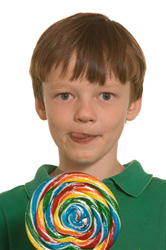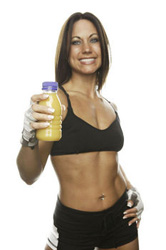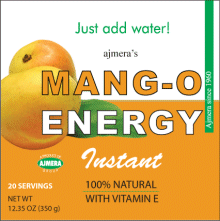Artificial Colors: Is the “Secret Shame” of the
Food Industry Harming Your Children?
by www.SixWise.com
Artificial colors are among the most questionable food additives there are, yet despite their potential health risks they’re added to countless food products ranging from candy and soda to breakfast cereal and sausage.
|

Numerous studies have linked artificial food colors with hyperactivity and behavior problems in children.
|
Decades ago in 1955, it was deemed safe for people to ingest 12 mg food dye per day. By 2007, that amount had reached 59 mg per person, per day, according to the U.S. Food and Drug Administration (FDA) -- a level nearly five times greater than initially was approved.
At the heart of the debate is concern that the artificial dyes cause behavior problems and hyperactivity in children, a suspicion that emerged back in 1970. Around that time Dr. Ben Feingold, an allergist in San Francisco, reported that his patients improved when their diets were changed to avoid artificial food coloring.
“Numerous controlled studies conducted over the next three decades in the United States, Europe, and Australia proved that some children’s behavior is worsened by artificial dyes, but the government did nothing to discourage their use and food manufacturers greatly increased their reliance on them,” reports the Center for Science in the Public Interest (CSPI).
Recently, a handful of studies have all gathered data showing that artificial dyes negatively impact children’s behavior. One of the most revealing was a British study from the University of Southampton, published in the journal The Lancet. The study examined the effects of mixes of additives on nearly 300 children, and found artificial food colors and additives exacerbate hyperactive behavior in children.
Now, CSPI is urging the FDA to ban eight widely used artificial food dyes linked to hyperactivity and behavior problems in children, including:
- Red 40: This is the most widely used food dye, found in soda pop, candy, gelatin desserts, pastries, pet food and sausage. Key tests involving the dye were found to be flawed and inconclusive, according to CSPI, and although an FDA committee acknowledged potential problems, they said the evidence was not “consistent.” It may be linked to hyperactivity disorders and migraines.
- Yellow 5: Found in gelatin dessert, candy, pet food and baked goods, this second most widely used coloring causes allergic reactions, primarily in people sensitive to aspirin.
- Yellow 6: As the third most often used food coloring, yellow 6 is found in many products, including backed goods, candy, gelatin and sausages. It has been found to cause adrenal gland and kidney tumors, and contains small amounts of many carcinogens.
- Blue 1: Blue 1, used to color candy, beverages and baked goods, may cause cancer.
- Blue 2: Blue 2, found in pet food, candy and beverages, has caused brain tumors in mice.
- Green 3: Used in candy and beverages, this dye has been suspected of causing bladder cancer.
- Orange B: Found in hot dog and sausage casings, this dye was found to cause urinary obstructions in rats that can lead to kidney damage.
- Red 3: This food coloring is used in cherries (in fruit cocktails), baked goods and candy. It causes thyroid tumors in rats, and may cause them in humans as well.
"The continued use of these unnecessary artificial dyes is the secret shame of the food industry and the regulators who watch over it," said CSPI executive director Michael F. Jacobson. "The purpose of these chemicals is often to mask the absence of real food, to increase the appeal of a low-nutrition product to children, or both. Who can tell the parents of kids with behavioral problems that this is truly worth the risk?"
|
Quench Your Thirst With 100% Natural Mang-O Energy

Delicious Mang-O Energy keeps you hydrated, and is 100% NATURAL with No Preservatives and No Artificial Colors or Flavors.
Mang-O Energy is perfect to replenish salts, vitamins and energy after a workout, tiring day or just when you need a boost.
- Mangos are an excellent source of vitamin C.
- Vitamin C is an antioxidant and can protect your body from free radicals.
- Vitamin C is responsible for producing collagen. Collagen is present in your muscles and bones and holds the cells together.
- Vitamin C supports your immune system.
- Vitamin C also supports gum health.
Learn More and Order Mang-O Energy Now!

|
Their Use is Unnecessary
Given that food dyes are used for purely aesthetic purposes, often in products intensively marketed to children, their use is highly questionable. Further, many of the dyes still in use in the United States have been phased out (or are in the process of being phased out) in Europe.
Because regulators and consumers there refuse to tolerate potentially unsafe food additives in their foods, manufacturers have responded by using natural colorings. For instance, according to CSPI:
-
Starburst Chews, Skittles, and M&M candies made by Mars are loaded with artificial dyes in the U.S., but in the U.K. natural colorings are used.
Isn’t it time people and children in the United States started demanding the same level of food safety that is already a given in other countries?
How to Minimize Artificial Dyes in Your Diet
With any processed food you run the risk of coming across additives and dyes, and reading through ingredient labels can be like trying to decode a puzzle.
Centering your diet on fresh, whole foods is the best way to stay away from unsavory additives and dyes, but assuming you do include some processed foods in your diet you’ll need to become an avid label reader. Diligently avoid those that contain the dyes listed above, and preferably look for those that contain only natural coloring.
One of our all-time favorite beverage brands, Ajmera, carries just such products. Ajmera's Orang-O Energy , Coco Energy and Mang-O Energy are 100% natural with NO caffeine, no preservatives, no synthetic food colors and no artificial flavors. All three of Ajmera's beverages will keep you tastefully hydrated without having to worry about potentially dangerous dyes!
Further, according to CSPI, everything with a Trader Joe's label sold at the supermarket and all products at Whole Foods are free of the controversial chemicals. At other health food stores, farmer’s markets and food coops, you’ll also likely be able to find foods free of artificial dyes.
Recommended Reading
12 Dangerous Food Additives: The Dirty Dozen Food Additives You Really Need to be Aware Of
Are Metals in Food Harming Your Child’s Behavior?
Sources
Center for Science in the Public Interest June 2, 2008
FoodNavigator-USA.com June 4, 2008
The Lancet Volume 370, Issue 9598, November 2007, Pages 1560-1567
Center for Science in the Public Interest: Food Additives